I’ve driven through Grand Junction, Colorado, at least two or three times, but I hadn’t taken the time to stop and investigate the nearby Colorado National Monument until my most recent cross-country trip. Located just a few miles off the interstate (literally a 5-minute drive on a single road), the monument boasts sweeping canyon vistas, impressive stone spires, and plenty of hiking trails. A campground nestled among the juniper and pinyon pine trees is a few tenths of a mile from the most impressive views, and the Visitor Center offers similarly excellent access to incredible vistas. I spent a day visiting the various overlooks and hiking a few trails; I certainly didn’t see everything and would love to return to see more!
Trip Planning
While hiking and camping in Colorado National Monument are entirely possible, there are a few things to consider that you might safely ignore in more hospitable climates. This is a desert; there is little shade and little water. In fact, what water you can find is not potable, even with filtration, due to a high Selenium content. Thus, you must pack in or cache all the water you need for the duration of your trip.
Route: Since I only had a day to spare from my road trip, I explored the park in two stages. First, I visited all of the overlooks via car and got a feel for what the different hiking options were like. Second, I stopped by to ask the rangers’ thoughts on hikes. They didn’t have any strong opinions, so I picked two hikes that seemed most interesting: Ute Canyon and Monument Valley.
Permits & Regulations: Backcountry camping is allowed in the canyons (subject to a few restrictions) with a free permit obtained from the rangers at the Visitor Center. You can also camp in the frontcountry at Saddlehorn Campground for a small fee of $20/night with access to clean water, flush toilets, and the excellent Canyon Rim Trail. For more information, check out the NPS website or give the rangers a call! Finally, National Geographic prints a detailed map of the monument; the same map also includes McInnis Canyons, Fruita, and Grand Junction.
Ute Canyon
May 8, 2018 | 8 mi | +/- 1200 ft | Class 1 | View on Map
One of several canyon-floor routes, the Ute Canyon Trail winds through groves of cottonwood trees and seemingly endless miles of junipers, all the while surrounded by towering red sandstone cliffs. You can reach the trail from three locations: the Ute Canyon trailhead, located near mile 13.5 on Rimrock Drive, or via the Lower or Upper Liberty Cap trailheads. I begin at the Ute Canyon trailhead because it has the most immediate access to the canyon, although that access is a half-mile of trail which descends a series of steep switchbacks from the rim to the floor.
Once at the valley floor, my first inclination is to hike up the canyon but, after only a hundred yards, I reach a thick wall of willows and decide to see what the trail looks like in the opposite direction. Thankfully, the down-canyon path is much clearer and soon I’m strolling down single-track. The National Geographic map labels this trail as “unimproved” which, frankly, seems perfect to me.
Almost immediately, I happen upon a small ditch of stagnant water. Selenium or not, I have no desire to drink any. A stand of nearby cottonwood trees, which frequently grow in close proximity to water, rustle gently in the morning breeze. The cottonwoods remind me of the canyons in Death Valley, where they also served as water markers, although those trees were dark autumnal colors and these are neon-green.
I meet a few other people on the trail: a middle-aged couple and, later, an older woman wearing a trail ambassador uniform. They must do a lot of hiking out here in sunny canyon country because all three are incredibly tan. The trail ambassador points out a few things to watch out for, including the fishhook cactus that is currently in bloom and collared lizards. I’ve seen plenty of small lizards darting away as I walk along, but no colorful reptiles that match the collared lizard description. However, now on the lookout, I spot a few sunning themselves on a rock further down the canyon.
By the time I reach the mouth of Ute Canyon, the sun is high in the sky and it’s beginning to get quite warm. I hurry back up the canyon, retracing my steps until I reach a grove of cottonwoods. I eat lunch and take a break in the shade before returning to the switchbacks and climbing out of the canyon.
Wedding Canyon – Monument Valley Loop
May 8, 2018 | 4.5 mi | +/- 870 ft | Class 1 | View on Map
Both the rangers at the Visitor Center and the trail ambassador I met in Ute Canyon recommended hiking the Monument Valley trail. The trail ambassador additionally recommended that I make it a loop hike, beginning on the Wedding Canyon trail and then returning via the Monument Valley trail. That seems like a great plan to me, so, after napping a bit through the afternoon heat, I hit the trail again!
The first section of the trail weaves through the desert, skirting the barbed-wire fence that borders the monument. The path soon turns into Wedding Canyon and climbs unforgivingly up steep, gravely inclines. I can see why the woman I met on the trail advised going up this trail instead of down; it’s much easier to climb than descend the loose gravel. An added benefit of hiking the loop in this direction is that I’ll have a grand view of the monuments during the warm evening light.
As I climb higher into the canyon, those grand views begin to materialize. The trail skirts the northern cliff and heads straight for Independence Monument, a lone spire isolated from the other canyon walls by the relentless forces of erosion. I soon reach the base of the monolith and spend a minute or two staring up at it. Apparently, this wall of rock is a popular climbing spot; so popular that the National Park Service has outlawed camping on top of the monument. Seems like a poor campsite – it’s got to be windy, and you’d have to repel all the way down to poop – but I can understand the appeal of being able to say you’d camped on top of the rock.
My path back to the trailhead follows the Monument Valley trail. A fellow hiker walking in the opposite direction warns me of a herd of bighorn sheep on the trail ahead. By the time I arrive, they’ve moved off the trail but are still grazing in the rocks nearby. There must be at least 20 or 30 of them, all munching on grass, seemingly unconcerned with the humans trekking past.
The remainder of the trail doesn’t present much additional interest. I hurry down stone steps, a much easier descent than the Wedding Canyon route offers, and hike past a dozen fancy houses built on the outside of the tall monument border fence. By the time I reach my car and return to camp, the sun has set and it’s time for bed.
Canyon Rim Trail
Due to the proximity of my campsite to the Canyon Rim Trail, I visited this scenic path several times during the sunrise and sunset golden hours. The views are incredible, with several fantastic compositions that include the monuments and canyon walls. There are all kinds of places to sit and watch the light play across the stone, but be careful to avoid falling off the edge; the sand can be slippery, there are no fences, and it’s a very long, uninterrupted drop to the canyon floor.
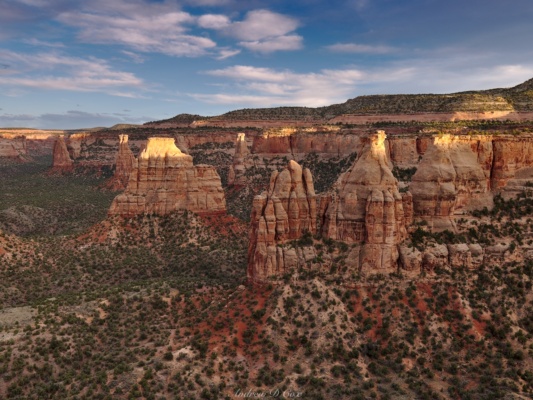
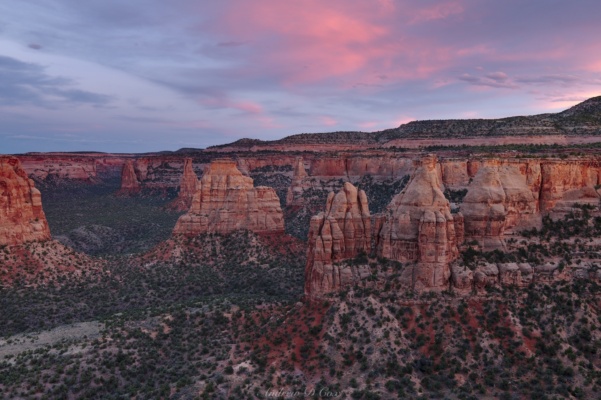
Colorado National Monument is a fantastic hiking and photography spot. If you’re passing through Grand Junction, take a few hours to visit, hike, and admire the views. It is well worth your while!
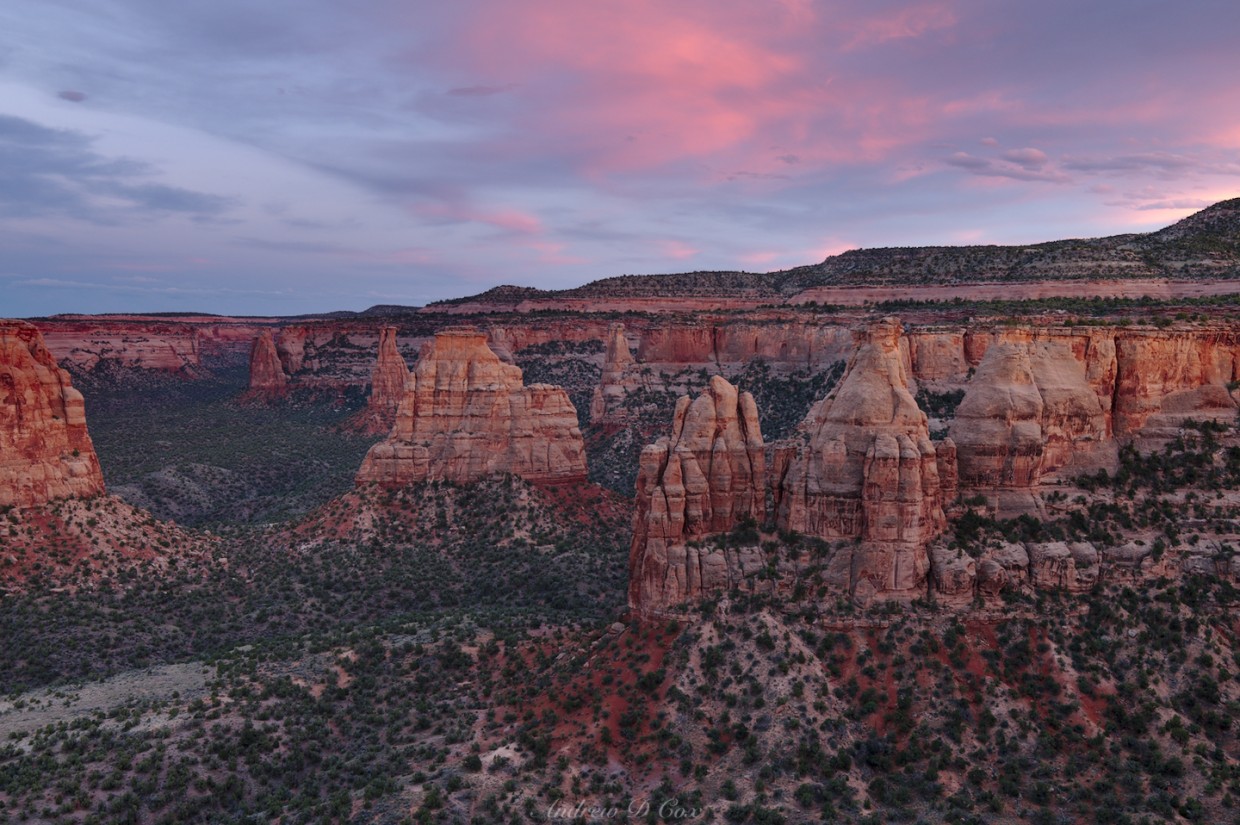






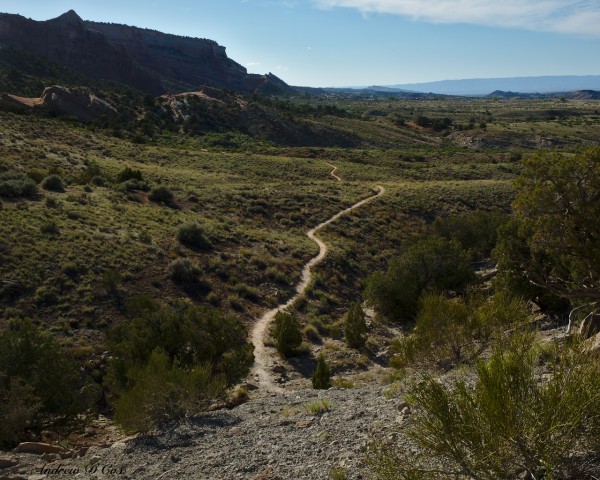



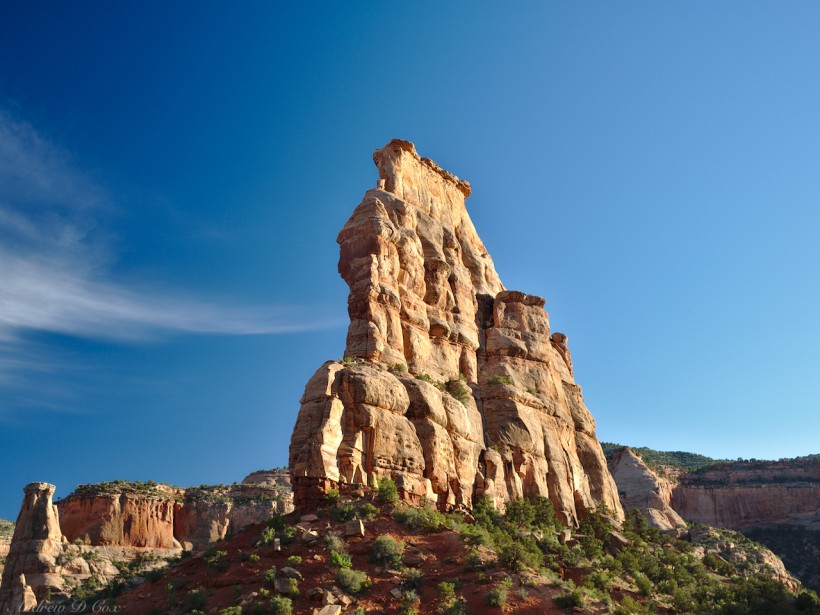
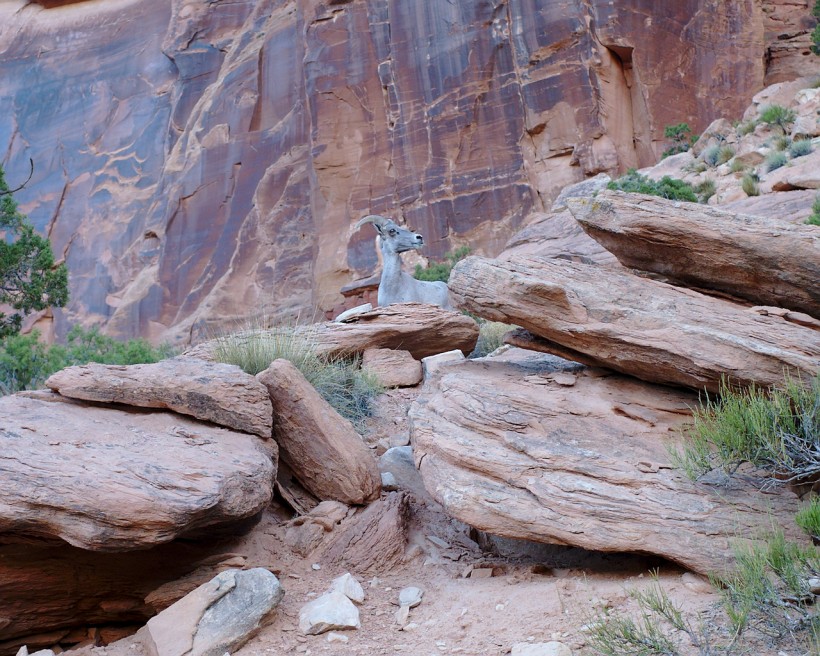


Dad 17 May 2018
Beautiful sunset and I love the sheep and lizards! Thanks for writing this up, Andrew!